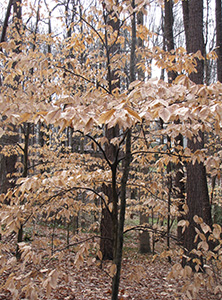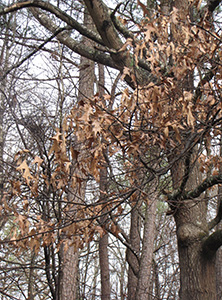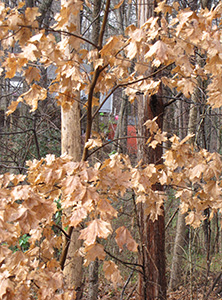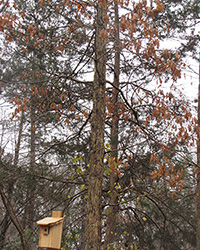Leaf it to the Trees to Know What's Best
Leaf it to the Trees to Know What's Best
By the Site Ecology Team (SET) and Wildlife and Industry Together (WAIT)
January 29, 2016



As wood be the case, we’re going to branch out, and shed some light on a botanical question that is often observed and could flummox you. The findings presented should leave everyone more in tune and empathetic, accepting that the reason is not fully understood. So, into the forest we go.
In the autumn/fall, trees don’t always shed their leaves when or where folks would like. This causes those folks to have a less than positive opinion of dead brown leaves especially when they’re lying everywhere. From a raking standpoint, it would save time if all leaves fell together and we’d rake once and be done (winds cooperating). But that isn’t the way it usually happens.
We know that leaf drop (not to be confused with possum, acorn, or egg drop) can occur when a tree becomes stressed, such as exposure to severe drought, drying winds, low nutrition, physical damage or pest attack such as fungus. To counter this stress, trees like dogwoods (Cornus), tulip populars (Liriodendron), ash (Fraxinus), and newly planted specimens lose their leaves, so that exposed surfaces are reduced or minimized.

In the fall a different set of circumstances occurs (temperature and day length change). The deciduous hardwood trees undergo a metabolic/enzymatic change in which the leaves change color and are shed, to be replaced by entirely new foliage the following season. Those trees that renew only a few leaves over the course of the year [evergreens like pines, conifers, and the live oaks (Q virginiana)], keep most of their leaves or needles during winter months to remain green. Trees like the birch (Betula), maple (Acer), ash (Fraxinus) and cherry (Prunus) are short leafed in that they give up all leaves early.
But, not all the deciduous trees shed completely. The American Beech (Fagus), various oaks (Quercus), sycamore (Plantanus), ironwood (Ostrya), and hornbeam (Carpinus) will hang on to some leaves over winter. The term for this is Marcescence, the retention of dead leaves on deciduous trees through the winter. The sugar maple may occasionally exhibit marcescence.
The lower branches or the entire tree may be affected.
How and why does this happen and is there an ecological advantage to the tree other than to watch people rake longer?

The HOW: There is a layer of cells between the leaf stalk (petiole) and the twig/stem that seals off the vessels from that twig, and allows for the individual leaf to drop. These cells are sensitive and influenced by nutrients, temperature, and light. A quick cold snap can disrupt this process from being completed and the leaf dies but stays on the branch. If the wind doesn’t dislodge the leaf, then the growing bud that develops in the spring will push the leaf off.
The WHY: This is not as clear-cut and various opinions and theories have arisen. If the first trees on earth were evergreens, then are the trees, displaying this leaf retention, evolutionarily retarded or not? Genetics play a role but epigenetic modifications are probably at play. Some ideas include:
- As mentioned earlier, having leaves fall over a wider time interval, increases outdoor activities for the yard enthusiast
- We recognize the importance of this nutrient source to the plants and animals of the forest. This would renew nutrients that might have leached from the soil. Problem is that oak leaves don’t decay rapidly and the effect is minimal. But consider this also, most of the trees that show Marcescence are found on poor sites, where the weather is dry, cold, and deer are present. Every bit of nutrition helps
- In the case of small trees, they are juvenile and may have not been taught any better. If under a canopy, they may be protected longer, more photosynthesis could occur, and then the abscission layer is killed when really cold comes. However, trees in an open exposure have this characteristic also
- Another thought is that the dead leaves protect the dormant buds from severe cold or wind damage. But if only a portion of the leaves are retained, wouldn’t damage show up elsewhere the next spring? Usually it doesn’t. Most of the retention occurs on the lower branches rather than at the top of mature trees
- How about this. The presence of dead leaves around the buds could provide some level of protection from winter herbivores such as deer and squirrels that eat buds and twigs. The
lower branches might then be less palatable than ones with exposed buds. The short deer declined to comment on this theory.
The leaves do provide birds with shelter from wind and rain. They also serve as a screen or sound barrier in the forest.
As can be seen, the question remains as to the WHY. It might be best to just accept the fact that leaf retention adds an additional dimension to the winter wood-scape by providing color and texture that might otherwise be lost. I would miss the rustling of leaves in the wind that serenades us.
We would welcome your thoughts.



